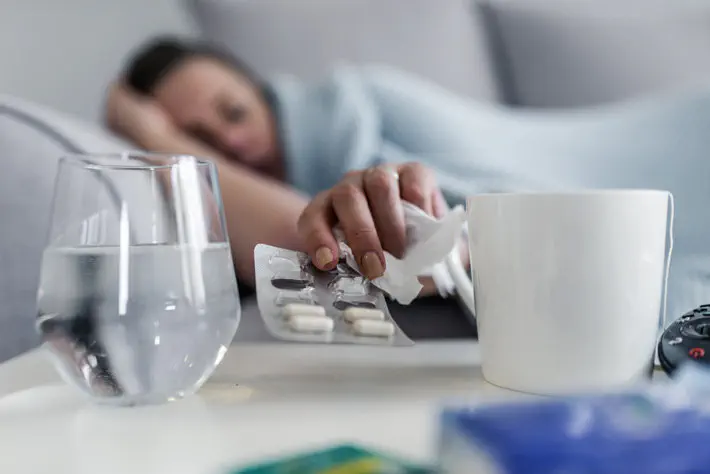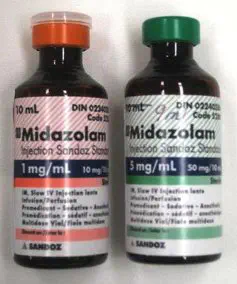DRUGS: WHAT YOU
NEED TO KNOW Booklet

Signs and Symptoms of Benzodiazepine Use

The word benzodiazepine refers to a type or category of drug typically used as an anti-anxiety drug or to induce sleep. They can also be used to quell panic attacks.
The long list of these drugs includes ones that act quickly and ones that take longer to take effect but that last longer. They are usually prescribed in pill form and may be used as part of surgical anaesthetic formulas.
Frequently prescribed drugs (along with their better-known brand names) in this class include: 1

Courtesy of DEA.gov
- Estazolam, Pro-Som
- Flunitrazepam, Rohypnol
- Flurazepam, Dalmane
- Loprazolam, Dormonoct
- Midazolam, Versed or Buccolam
- Nitrazepam, Modadon or Pacisyn
- Temazepam, Normison
- Triazolam, Halcion
- Alprazolam, Xanax or Alprox
- Chlordiazepoxides, Librium or Klopoxid
- Clonazepam, Rivotril
- Diazepam, Valium or Stesolid
- Ketazolam, Anseren
- Oxazepam, Serax or Oxabenz
- Nordazepam, Stilny
Just in the last few years, many more benzodiazepines have been added to the list of benzodiazepines monitored by the European Monitoring Centre for Drugs and Drug Addiction—seventeen more since 2014.2 Some of these drugs are non-medical “designer benzodiazepines” meaning that they were not developed or produced by pharmaceutical companies.3 They are illicit drugs.
All these drugs work by suppressing the actions of the central nervous system. This effect makes a person more relaxed and sleepy which is why they work as anti-anxiety drugs. Some are classed as hypnotics which means they have more of a sedating effect. Benzos (as they are often called) are also used to prevent seizures in people who have epilepsy or are withdrawing from alcohol addiction.
When a person has too much of this drug in their system—which can happen if they take too much or their bodies can’t break down the drug quickly enough—the following symptoms can result: 1-4
- Drowsiness
- Dizziness
- Unsteady walking
- Mental confusion
- Poor judgment
- Amnesia
- Greater risk of falling
- Deterioration of cognitive function
- Inability to drive safely
- Hostility
- Aggressive behaviour
- Low blood pressure
- Fainting
An older person or one whose liver, lungs or kidneys do not work properly is more likely to suffer from too-high levels of benzodiazepines and therefore, these adverse effects.
Benzodiazepines are addictive. Professionals recommend prescribing benzodiazepines for no longer than two or three weeks because of their addictiveness. A person who has taken these drugs long-term or has become addicted to them while abusing them is likely to suffer the following symptoms when they try to withdraw: 2
- Increased anxiety
- Agitation
- Confusion
- Panic attacks
- Acute psychosis
- Seizures
Abuse of Benzodiazepines
Unfortunately, benzodiazepines are popular among the addicted. Users of benzodiazepines rarely use just this one drug by itself. It’s much more commonly abused by polydrug users. These individuals either use multiple drugs at one time, combining them to create a specific effect on themselves, or they may use different drugs at different times. An opioid in the evening and a stimulant in the morning, for example.
Those most likely to abuse benzos are high-risk opioid users.2 When used with either opioids or alcohol, benzos increase the risk of a fatal overdose. That’s because all three of these classes of drugs suppress the function of the central nervous system. When abused together, their effects can combine to overwhelm the body to the point that it stops breathing or the heart stops beating.
Most benzodiazepines that are being misused by addicted people are diverted from legitimate pharmaceutical sources. Some, particularly Xanax bars, are counterfeited and could contain any combination of drugs, including fentanyl.5
How Are Benzodiazepines Being Misused?
The pills are swallowed either when they are not prescribed or in higher doses than intended. They are also crushed to powder so they can be sniffed up the nose. They may be dissolved so they can be injected.
When combined with an opioid—like heroin, hydrocodone or oxycodone—benzos increase the euphoric effects of those drugs. A person abusing psychostimulants like cocaine or amphetamine may add a benzodiazepine to reduce the harsh effects of the stimulants.
The tragedy of benzodiazepine abuse is the number of injuries it causes and deaths it contributes to, nearly always in a polydrug situation. In one study by the European Drug Emergencies Network, 1,345 cases in which heroin users arrived at emergency rooms to get help were analyzed.6 Of these cases, 662 used heroin only, and 191 had used heroin along with one or more benzodiazepines. Those who had used both drugs were more likely to be suffering from more severe respiratory distress requiring hospitalization. The three benzos seen most often were clonazepam, diazepam, and alprazolam.
In Spain, data on drivers who had positive drug tests were assessed to determine which drugs were found most often.7 In these 65,000 positive drug tests, 4.3% of those tests were positive for benzodiazepines. Among all the tests, cocaine and cannabis were the most common drugs detected. Positive benzodiazepine tests were most common among younger drivers.
Benzodiazepine Abuse Across Europe
A simple survey of drug users will never collect completely accurate information on which drugs they are using because the responses of users are seldom honest and complete. For that reason, the European Syringe Collection and Analysis Project Enterprise was launched to assemble more accurate data.8 This project collected used needles used for illicit drug injection and analyzed the residues left in the syringe.
The city with the highest percentage of benzodiazepines in these needles was Lausanne, Switzerland at 23%. In Helsinki, Finland, 11% of the needles contained a benzodiazepine, as did a small number of needles in Glasgow, Scotland.
In 2015, the data from 42,700 people who sought admission to drug rehab programs for help with opioid addiction was inspected to determine how many also abused benzodiazepines.9 Of this group, 12,000 people cited benzodiazepines as the secondary drug involved in their addictions.
Benzodiazepines may not have the high profile of heroin, cocaine or amphetamines, but they are contributing to addiction and ruined lives across Europe.
Sources:
-
European Monitoring Centre for Drugs and Drug Addiction, “Benzodiazepines drug profile” EMCDDA Article ↩︎ ↩︎
-
European Monitoring Centre for Drugs and Drug Addiction (2018), “PERSPECTIVES ON DRUGS The misuse of benzodiazepines among high-risk opioid users in Europe” EMCDDA Publication (PDF) ↩︎ ↩︎ ↩︎
-
Jolanta B.Zawilska JakubWojcieszak, ScienceDirection.com (2015), “An expanding world of new psychoactive substances—designer benzodiazepines” ScienceDirect Article ↩︎
-
United Nations Office on Drugs and Crime (2017), “Global Smart Update— Non-medical use of benzodiazepines: a growing threat to public health?” EMCDDA Publication: (PDF) ↩︎
-
The Partnership for Safe Medicines (2020), “Counterfeit Medicines Are A Problem In The European Union—A Problem That Is Continuing To Grow” Article ↩︎
-
Yamamoto T, Dargan PI, Dines A, Yates C, Heyerdahl F, Hovda KE, Giraudon I, Sedefov R, Wood DM, Euro-DEN Research Group—Europe PMC “Concurrent Use of Benzodiazepine by Heroin Users-What Are the Prevalence and the Risks Associated with This Pattern of Use?” EuropePMC Article ↩︎
-
Francisco Herrera-Gómez, Mercedes García-Mingo & F. Javier Álvarez—BMC Part of Springer Nature(2020) “Benzodiazepines in the oral fluid of Spanish drivers” BMC Article ↩︎
-
European Monitoring Centre for Drugs and Drug Addiction (2019), “Drugs in syringes from six European cities Results from the ESCAPE project 2017” EMCDDA Publication: (PDF) ↩︎
-
European Monitoring Centre for Drugs and Drug Addiction, “The misuse of benzodiazepines among high-risk opioid users in Europe” EMCDDA Article ↩︎

 ®
®
